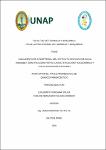Aislamiento de kaempferol del extracto de hojas de Senna reticulata e identificación por su caracterización fisicoquímica y espectroscopía UV/visible

Date
2024Author
Vergara Souza, Edilberto
Chunga Moreno, Carlos Fernando
Metadata
Show full item recordAbstract
Senna reticulata is an Amazonian plant of the Fabaceae family widely used in traditional medicine. The infusion of its flowers is used to treat inflammations liver diseases and stomach pains, while the leaves are used in the local treatment of cutaneous mycosis. The study aimed to isolate the compound kaempferol from the leaves of S. reticulata and to identify it by characterization of its physicochemical properties and spectroscopic analysis. The samples were collected in the hamlet of Ullpa Gallo, District of Belén, province of Maynas, Loreto Region, in the Peruvian Amazon. To isolate kaempferol, the procedure described by Domínguez Sepúlveda Xorge was used with a small modification. Yellow needle-shaped crystals were obtained with a yield of 0.475%, melting point of 278°C, and molecular weight of 286.02 g/mol. The hRf values in thin layer chromatography (TLC) in different solvents of resolution were: 39 in [toluene: chloroform: acetone], 20 in [benzene:butanone: methanol], and 8 in [water-butanone-methanol] respectively. The maximum absorption wavelengths in methanol were recorded at 266 and 367nm and in [methanol: acetic acid] solution at 274, 303, and 387nm, values similar to those reported in the literature. S. reticulata from the Peruvian Amazon could serve as a source of raw material to isolate kaempferol for medicinal purposes in phytotherapy and the pharmaceutical industry. Senna reticulata es una planta amazónica de la familia Fabáceae ampliamente utilizada en la medicina tradicional. La infusión de sus flores se emplea para tratar inflamaciones y enfermedades hepáticas y dolores de estómago, mientras que las hojas se utilizan en el tratamiento local de micosis cutánea. El estudio tuvo como objetivo aislar el compuesto kaempferol de las hojas de S. reticulata e identificarlo mediante la caracterización de sus propiedades fisicoquímicas y análisis espectroscópico. Las muestras fueron recolectadas en el caserío de Ullpa Gallo, Distrito de Belén, provincia de Maynas, Región Loreto, en la Amazonía Peruana. Para aislar el keampferol se usó el procedimiento descrito por Domínguez Sepúlveda Xorge con una pequeña modificación. Se obtuvo cristales amarillos en forma de agujas con un rendimiento de 0,475%, punto de fusión 278°C y peso molecular 286,02 g/mol. Los valores hRf en cromatografía de capa fina (TLC) en diferentes solventes de resolución fueron: 39 en [tolueno: cloroformo: acetona], 20 en [benceno:butanona:metanol] y 8 en [agua-butanona-metanol] respectivamente. Las longitud de onda máxima de absorción en metanol se registraron a 266 y 367nm y en solución de [metanol:ácido acético] a 274, 303, 387nm, valores similares a los reportados en la literatura. S. reticulata de la Amazonía peruana podría servir como fuente de materia prima para aislar kaempferol con fines medicinales en fitoterapia y en la industria farmacéutica.
Collections
- Tesis [298]

